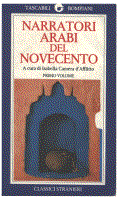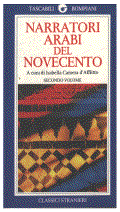|
Recensione di Roger Allen a Narratori arabi del Novecento, comparsa su “Oriente Moderno ”, XIII, 1-6, 1994
During a visit to the United States for medical treatment in the 1980s, the great Egyptian short-story writer, Yusuf Idris (1927-1991), had a long telephone call with me during which we discussed the comparative status of the short story genre between Western and non-Western cultures. He wondered to what extent it was true that the short story in the Western world had lost some of its creative vigour. By becoming a part of the narrative "canon", it seemed to Idris, the short story's original sense of adventure and experiment had been somewhat blunted, and its modes of publication appeared to earn it a comparatively low status in the narrative pantheon. It had become an ephemeral, throw-away genre, published in monthly magazines; its artifice might be much admired by a small coterie of readers, but it had been curiously neglected by the critical establishment. By contrast, Idris boasted about the status of the short story in the Arab world, where it was unchallenged as the most popular and widely published narrative genre; collections of a bewildering variety - in terms of topic, technique, and quality - appeared on a regular basis in every country of the region. While the characteristic sweep of these remarks of Idris may give rise to a certainly scholarly caution, there seems little reason to doubt the fact that, whereas collections of short stories are not a mode of publication that finds much favour among publishers in the Western world, the student of the Arabic short story is faced with an astonishing output. The anthology of lsabella Camera d'Afflitto, under review here, is thus particularly welcome, in that it is the most thoroughly representative collection of short stories in Arabic available many Western language.
The quality of "representativeness" in this collection comes in a number of guises.
In the first place, there are very few anthologies of the Arabic short story that include authors from so many areas of the Arab world: not merely the "central" and much studied traditions of Egypt and Lebanon, but those of the Maghribi countries - Morocco, Algeria, and Tunisia, the Sudan, and the Arabian Peninsula. Secondly, women writers are represented, from pioneers like Ulfat Idlibi and Samirah 'Azzam to more modern writers like Gadah al-Samman, Hanan'al-Sayh, and Basimah Nassur. In both these categories choices have been made, and one can draw attention to some omissions; in the former, for example, Yemen, the Arabian Gulf, and Saudi Arabia itself, could each have had one or two more examples; in the latter, I would personally have favoured the inclusion of more women writers such as Layla Ba'albakki from the earlier period and Salwà Bakr from the more recent. However, as an anthologiser myself, I am well aware that this is an easy game for reviewers to play; every anthology is a matter of making selections, and it is sufficient to note that the variety of the inclusions in this collection is a pleasing one. .
This two-volume anthology is subdivided into four sections, each one representing a time period and phase in the development of the short story genre. This basically chronological arrangement places greater emphasis, needless to say, on matters of time and place than a topically or theoretically organized anthology would, but the sheer variety of approaches to be found within this genre throughout the Arab world still manages to make itself abundantly evident. We start with the pioneers beginning in the 1920s and even earlier and continuing to the end of the Second World War: Miha'il Nu'aymah. for example, Mahmud Tahir Lasin, Yahyà Haqqi, Ulfat Idlibi, and Ali al-Du'agi presenting us with intimate character sketches, snatches of daily life, and unusual incidents, many of them connected with the intricacies of family life. The second period covers the "revolutionary" period of the 1950s and '60s until the debacle (naksah) of 1967. With this group of writers, including Nagib Mahfuz, Yusuf Idns, Fu'ad al-Tikirli and Samirah 'Azzam, we enter a fictional world that is both darker in its vision and more accomplished in its artistry - the short story, of course, being generally acknowledged by those relatively few critics who have devoted much attention to it as the most "artificial" (in the sense of 'making art') of all literary genres. Mahfuz's masterpiece Za'balawi is here, and so is Yusuf Idris's Hiya, an expression of his more symbolic and sinister side that was to came to the fore in the 1960s; bearing in mind the breadth and importance of Idris's output, I would have wished for the inclusion of one more of his stories, or even two. With the third part, we come to that group of writers who have come to prominence during the late 1960s and '70s; in the Egyptian context, they have been termed by Sabry Hafez the "generation of the '60s" and even the lost generation, in that they have suffered much at the hands of the political situation in their country but have emerged from their varied experiences to make major innovative contributions to modern Arabic fiction. The list is a long one, and include Edward al-Harrat, Gamal al-?Gitani, Baha' al-Tahir, and Sun'allah Ibrahim; I would have liked to see at least Yahyà al-Tahir 'Abdallah and Magid Tubiya included among their number here. Alongside the thriving Egyptian school we find excellent contributions from across the Arab world: Zakariyya Tamir, Gassan Kanafani, al-Tahir Wattar, al-Tayyib Salih (his classic tale, Hafnat tamr), Muhammad Barradah, Muhammad Sukri, 'Izz al-Din al-Madani (a wonderful example of his continuing experiments- games, perhaps – with narrative al-Muhagir alladi lam yuhagir), and 'Abd al-Rahman Munif. It is particularly in this section that the balance of gender that I noted above - with only Mayy Muzaffar's Awraq sahsiyyah to represent women writers - seems in need of redress. Finally we broach the "contemporary period, to find this anthology offering an accurate reflection on the current situation in the target culture itself: a curious mixture of more traditional types of' realism" coming from the pens of writers in the emerging literary traditions placed alongside thoroughly experimental narratives from writers working within short story traditions of greater longevity.
Since I am not a native-speaker of Italian, I cannot comment about the idiomatic qualities of the narrative style as it has emerged in these stories, but I can note that the target text of the examples that I have compared with both Arabic originals and (where they exist) English versions is an accurate rendering of texts written in a wide variety of styles and levels of language. Equally admirable are the referential materials that are provided. The organization of the collection is clearly explained by the editor (who herself translated all but four of the stories), and judicious footnotes are provided to explain aspects of the source culture. The first volume also includes a precise and accurate account of the development of the short story in Arabic, as well as a useful bibliography on the subject and a chronology of significant events in the history of the Middle East since 1917. The two paperback volumes are well printed and attractively presented, being encased in a presentation box illustrated with arabesque.
Readers of Italian are fortunate in having access to the short story tradition of Arabic through a comprehensive and affordable anthology that serves as an excellent introduction to the subject. We are all in the debt of its editor and publisher.
Inizio pagina |

